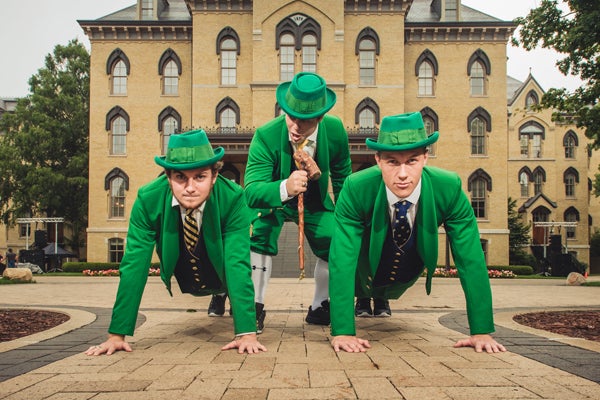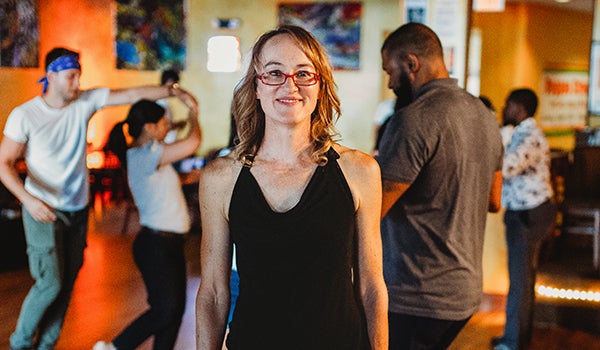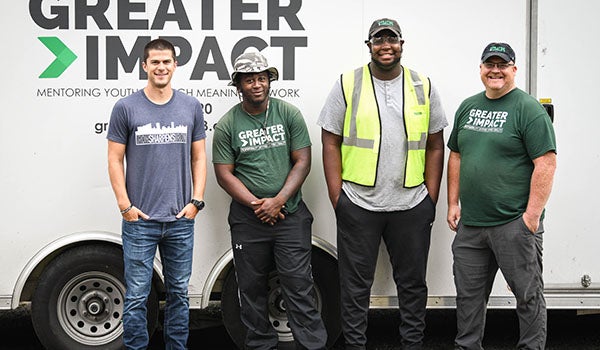Notre Dame’s iconic leprechauns instill spirit in South Bend
It is a crisp fall morning in South Bend and football fans from across the country are pouring into the University of Notre Dame parking lots to tailgate in the shadow of the towering stadium. In the smoke of grilling meat and clink of cold beverages, they pull out yard games like cornhole and frisbee, building their energy in anticipation for the game. Inside the stadium just before game time, restless fans dressed in blue and gold fill the seats of the more than 80,000 capacity facility.
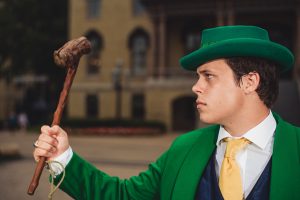 At the brink of the field, the university’s leprechaun mascot waits, poised in a dapper green suit and Bowler hat. With a burst of energy, he storms the field, raising a flag bearing the school’s iconic emblem, supercharging the fans into a deafening roar, as football players flanking just behind him enter the field from the tunnel.
At the brink of the field, the university’s leprechaun mascot waits, poised in a dapper green suit and Bowler hat. With a burst of energy, he storms the field, raising a flag bearing the school’s iconic emblem, supercharging the fans into a deafening roar, as football players flanking just behind him enter the field from the tunnel.
Soon, the game begins.
A folklore synonymous with mischief, the leprechaun mascot at the University of Notre Dame has also come to stand for the grit and determination that the Irish take onto the field each Saturday during football season.
The leprechaun was first used as an icon for the school in the early 1960s and was intended to represent the “tenacious spirit and determination of the Fighting Irish,” according to the university’s website. As an icon, the leprechaun with his crooked hat and raised fists is a symbol for Notre Dame and the greater South Bend community.
Carrying that legacy onto the fields, courts and ice rinks this year are three men whose passion for the Fighting Irish might be as fiery as the stereotypical leprechaun’s red beard: 19-year-old Conal Fagan, a political science major; 21-year-old Andrew Bub, who goes by “Bub” and is studying computer science; and 21-year-old Jack Sheehan, an economics major.
Bearing the duties of the leprechaun is not all glamour and cheering fans. Leprechauns attend between two to three games a week on average — and this does not include the time they spend practicing with the cheer team, learning stunts and choreography.
Historically, those selected to represent the university as mascots are not fair weather fans in any sense of the term. They lead fans in cheer in even the coolest of temperatures and the most abysmal of scores. This year’s leprechauns are no exception: they like finding new ways to engage their crowd.
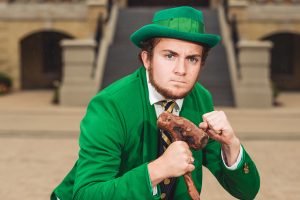 For Jack, a seasoned leprechaun, who earned a second-year term among dozens of others vying for the title, being a mascot involves the art of reading the fans that fill the bleachers.
For Jack, a seasoned leprechaun, who earned a second-year term among dozens of others vying for the title, being a mascot involves the art of reading the fans that fill the bleachers.
“Even if it is a small crowd with a few parents and kids watching, make a good experience of it,” Jack says. “Go over and talk to the little kids. Ask them who their favorite player is. [That’s] something that is going to make memories for the parents and the little kids, too.”
There’s also a community outreach component to the mascot. Leprechauns visit South Bend area schools and hospitals to interact with residents outside of the stadium.
Social media posts announcing the Garth Brooks concerts this fall include photos of Leprechaun Jack with the famous country star — a unique way of promoting the first concert ever hosted in Notre Dame stadium.
“That’s one of the most important things, being an ambassador for the school on and off of the field,” Fagan says. “And just enjoying it as well, because when people see us enjoying ourselves, it makes the crowd excited, especially when it’s the cold nights.”
The @ndcheerteam Instagram page is littered with photos of young students at South Bend schools like Holy Cross School, a grade school on the west side. Children put up their fists in true leprechaun style.
This effort to get outside of the campus and share a little Fighting Irish spirit is perhaps why the leprechaun is also a symbol that residents of South Bend can identify with, too.
“We do a lot of work in our community, whether it’s visiting schools or elderly homes” Bub said. “It’s more than just sporting events.”
The Notre Dame leprechauns and cheerleaders also serve their community by volunteering with organizations like the Food Bank of Northwest Indiana.
While there is no doubt that being a mascot takes a certain kind of spunk, this year’s leprechauns say they see the mascot as an opportunity to be part of the university and South Bend community in a bigger way. Each leprechaun who tries out for the role has their own motivations for wanting to be the icon, but their goal as the mascot remains largely the same: to cheer on the Fighting Irish and represent their school.
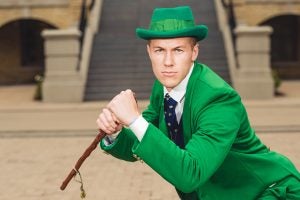 Bub, of St. Louis, first began growing his red chinstrap beard as a senior in high school and his friends jested that he had all the makings of a leprechaun. When he started studying at Notre Dame, he wore the classic leprechaun suit during tailgates.
Bub, of St. Louis, first began growing his red chinstrap beard as a senior in high school and his friends jested that he had all the makings of a leprechaun. When he started studying at Notre Dame, he wore the classic leprechaun suit during tailgates.
His likeness was so stark to that of the mascot that a 97-year-old woman once asked for her picture with Bub because she thought he was the mascot. She was so delighted by the photo opportunity that Bub says he did not have the heart to tell her he was not an official leprechaun at that time. However, it gave him a taste of just how much the feisty green icon means to Notre Dame and its fans.
“It’s a really neat experience to get to touch people’s lives like that,” Bub says.
For Jack, also of St. Louis, the draw to be a leprechaun was in his blood. Jack’s parents are “double domers” — both attended Notre Dame to earn their undergraduate and graduate degrees. As a child, every Halloween Jack says he would dress up as either a leprechaun or a football player. Now that he is a leprechaun at Notre Dame, he says his parents are ecstatic that he has fulfilled his childhood dream.
“My parents tell everyone that they meet that I am a leprechaun,” Sheehan says.
Like his fellow leprechauns, Conol, who is from Derry, Northern Ireland, says he was drawn to be the mascot because it allows him to be part of the university in a bigger way by being an ambassador.
The leprechauns have had similar experiences connecting with fans and they described this as one of the most rewarding parts of the gig.
“It’s something people are attached to,” Conol says. “Other schools have great school spirit, but I don’t think there is anywhere like Notre Dame that sort of has that same attachment. It’s part of [something] bigger. We are part of the community.”
Photos by Wes Jerdon/Westley Leon Studios

